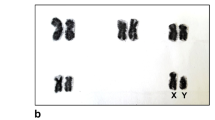Abstract
Different sex-determining mechanisms (♂: XO; X1X2O; X1X2X3O) were studied in species of the Lycosidae family, named for the purpose of description as follows: Lycosa sp.1 (malitiosa group), Lycosa thorelli Keyserling, Lycosa sp.2 (thorelli group) and Lycosa sp.3. While L. sp.1 (malitiosa group) shows a single metacentric sex-chromosome, L. thorelli and L. sp.3 present a multiple system (X1X2O). A new system (X1X2X3O) was found in L. sp.2 (thorelli group) (coexisting with L. thorelli in the same habitat). Its particular behaviour during meiotic prophase is discussed. The sex-chromosome lengths were compared in the statistical analysis. An anova test with two unequal classes (Group A = sex-chromosomes from X1X2O species; Group B = sex-chromosomes from X1X2X3O species) and the additional component variance were used for quantitative comparisons. A non-disjunction phenomenon in the second male meiosis is postulated as the origin of specimens with an X1X2X3O sex-determining mechanism.
Similar content being viewed by others
References
Benavente, R. & Wettstein, R., 1977. An ultrastructural cytogenetic study on the evolution of sex chromosomes during the spermatogenesis of Lycosa malitiosa (Arachnida). Chromosoma 64: 255–277.
Benavente, R. & Wettstein, R., 1978. Ultrastructural cytogenetics of the sex determination mechanisms of Araneids. Rev. Microscopia electron. 5 (1): 320.
Bole-Gowda, B. N., 1950. The chromosome study in the spermatogenesis of two lynx-spiders (Oxyopidae). Proc. zool. Soc. Beng. 3: 95–107.
Bole-Gowda, B. N., 1952. Studies on the chromosomes and the sex-determining mechanism of four hunting spiders (Sparassidae). Proc. zool. Soc. Beng. 5: 51–70.
Bole-Gowda, B. N., 1958. A study of the chromosomes during meiosis in twenty-two species of Indian spiders. Proc. zool. Soc. Beng. II: 69–108.
Brum-Zorrilla, N. & Cazenave, A. M., 1974. Heterochromatin localization in the chromosomes of Lycosa malitiosa (Arachnida). Experientia 30: 94–95.
Brum-Zorrilla, N. & Postiglioni, A., 1980. Karyological studies on Uruguayan spiders. I. Banding pattern in chromosomes of Lycosa species (Araneae-Lycosidae). Genetica 54: 149–153.
Diaz, M. O. & Saez, F. A., 1965. Karyotype of South-American Araneida. Mem. Inst. Butantan Symp. Int. 33 (1): 153–154.
Diaz, M. O. & Saez, F. A., 1966. Investigaciones citogenéticas sobre algunas especies de araneidos uruguayos. An. II Congr. Lat. Am. Zool. 2: 3–9.
Hackman, W., 1948. Chromosomenstudien an Araneen mit besonderer Berücksichtigung der Geschlechtschromosomen. Acta zool. fenn. 54: 1–101.
Hard, W. L., 1939. The spermatogenesis of the lycosid spider Schizocosa crassipes (Walckenaer). J. Morph. 65: 121–150.
Mittal, O. P., 1963. Karyological studies on the Indian spiders. I. A comparative study of the chromosomes and sex-determining mechanisms in the family Lycosidae. Res. Bull. (N.S.) Panjab Univ. Sci. 11: 59–86.
Montgomery, T. H., 1905. Spermatogenesis of Syrbula and Lycosa, with general considerations upon chromosome reduction and the heterochromosomes. Proc. Acad. nat. Sci. Philad. 57: 162–205.
Painter, T. S., 1914. Spermatogenesis in spiders. Zool. Jb., Anat. Ontog. 38: 509–576.
Patau, K., 1948. X-segregation and heterochromasy in the spider Aranea reaumuri. Heredity 2: 77–100.
Revell, S. H., 1947. Controlled X-segregation at meiosis in Tegenaria. Heredity 1: 337–347.
Robertson, W. R. B., 1916. Chromosome studies. I. Taxonomic relationship shown in the chromosomes of Tettigidae and Acrididae. V-shaped chromosomes and their significance in Acrididae, Locustidae and Gryllidae: chromosomes and variation. J. Morphol. 27: 179–331.
Sokolska, J., 1925. Les hétérochromosomes pendant la spermatogenèse de l'araignée domestique (Tegenaria domestica CL). Bull. Int. Acad. Sci. Lett. Cracovie 3B: 447–491.
Suzuki, S. & Okada, A., 1950. A study on the chromosomes of a spider, Heteropoda venatoria with special references to X1, X2 and X3 chromosomes. J. Sci. Hiroshima Univ. B, 11: 29–44.
Suzuki, S., 1954. Cytological studies in spiders. III. Studies on the chromosomes of fifty-seven species of spiders belonging to seventeen families, with general consideration on chromosomal evolution. J. Sci. Hiroshima Univ. B, 15: 23–136.
Wallace, L. B., 1909. The spermatogenesis of Angelena naevia. Biol. Bull. 17: 120–160.
White, M. J. D., 1973. Animal cytology and evolution. 3rd. ed. London, Cambridge Univ. Press.
White, M. J. D., 1975. Chromosomal repatterning. Regularities and restrictions. Genetics 79: 62–72.
White, M. J. D., 1978. Modes of speciation. London, Cambridge Univ. Press.
Author information
Authors and Affiliations
Rights and permissions
About this article
Cite this article
Postiglioni, A., Brum-Zorrilla, N. Karyological studies on Uruguayan spiders II. Sex chromosomes in spiders of the genus Lycosa (Araneae-Lycosidae). Genetica 56, 47–53 (1981). https://doi.org/10.1007/BF00126929
Received:
Accepted:
Issue Date:
DOI: https://doi.org/10.1007/BF00126929




